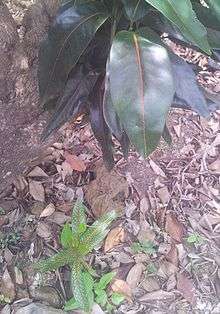Heteroblasty (botany)

Heteroblasty is significant and abrupt change in form and function that occurs over the lifespan of certain plants. Characteristics affected include internode length and stem structure as well as leaf form, size and arrangement.[1] It should not be confused with seasonal heterophylly, where early and late growth in a season are markedly different.[2]
The earlier and later stages of development are commonly labelled as juvenile and adult respectively, particularly in relation to leaves.[3]
The term was coined by German botanist Karl Ritter von Goebel, along with homoblasty for plants with leaf characteristics that do not change significantly. Leonard Cockayne observed that heteroblasty occurred in an unusually high proportion of tree species native to New Zealand.[4]
See also
- Lammas growth a second burst of growth late in the growing season exhibited by some trees, often different in appearance from spring growth
References
- ↑ Zotz, Gerhard; Wilhelm, Kerstin; Becker, Annette (2011). "Heteroblasty—A Review". The Botanical Review. 77 (2): 109–151. doi:10.1007/s12229-010-9062-8. ISSN 0006-8101.
- ↑ Eckenwalder, J.E. (1980), "Foliar Heteromorphism in Populus (Salicaceae), a Source of Confusion in the Taxonomy of Tertiary Leaf Remains", Systematic Botany, 5 (4): 366–383, doi:10.2307/2418518, JSTOR 2418518
- ↑ McCusker. "Flora of Australia Glossary". Department of the Environment, Water, Heritage, and the Arts. Retrieved 23 December 2014.
- ↑ Cockayne, Leonard (1912). "Observations concerning evolution, derived from ecological studies in New Zealand". Transactions and Proceedings of the New Zealand Institute. 44: 1–50.